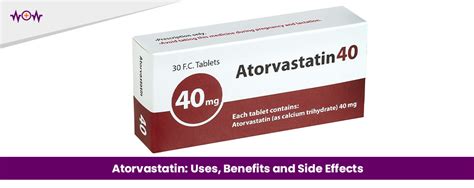Reducing the risk of heart disease is a top priority for many individuals, especially those with high cholesterol or a family history of cardiovascular issues. One medication that has been widely prescribed to help manage this risk is atorvastatin, a statin that works by lowering levels of “bad” LDL cholesterol in the blood. But what exactly is atorvastatin, how does it work, and what are its uses beyond just reducing cholesterol levels?
Understanding Atorvastatin
Atorvastatin, sold under the brand name Lipitor among others, belongs to a group of drugs known as HMG-CoA reductase inhibitors or “statins.” It functions by inhibiting the enzyme HMG-CoA reductase, which plays a central role in the production of cholesterol in the liver. By reducing the liver’s ability to produce cholesterol, atorvastatin leads to a decrease in the amount of cholesterol released into the bloodstream. This mechanism not only helps in lowering LDL (low-density lipoprotein) cholesterol, the “bad” cholesterol, but also has a positive effect on raising HDL (high-density lipoprotein) cholesterol, the “good” cholesterol, and reducing triglycerides, another type of fat found in the blood.
Primary Uses of Atorvastatin
Hyperlipidemia Treatment: Atorvastatin is primarily used to treat high cholesterol and reduce the risk of cardiovascular disease. It’s effective in lowering the levels of “bad” LDL cholesterol and triglycerides, while also increasing the levels of “good” HDL cholesterol.
Prevention of Cardiovascular Events: Beyond its cholesterol-lowering effects, atorvastatin has been shown to reduce the risk of heart attacks, strokes, and the need for revascularization procedures (like angioplasty) in patients with established cardiovascular disease or those at high risk of developing it.
Management of Heterozygous Familial Hypercholesterolemia: This condition is characterized by very high levels of LDL cholesterol due to genetic causes. Atorvastatin can help manage this condition by significantly lowering LDL levels.
Homozygous Familial Hypercholesterolemia: Though more challenging to treat, atorvastatin can be part of the management strategy for patients with this severe form of inherited high cholesterol, often in combination with other treatments.
Secondary Benefits and Uses
- Inflammation Reduction: Statins like atorvastatin have anti-inflammatory properties, which can contribute to their overall cardiovascular protective effects.
- Potential Role in Reducing Cancer Risk: Some studies suggest that statins may have a role in reducing the risk of certain types of cancer, though this area of research is still evolving and not conclusively proven.
- Cognitive Function: There’s ongoing research into whether statins can help reduce the risk of dementia or cognitive decline, with mixed results so far.
Implementation and Dosage
Atorvastatin is typically taken once a day, with or without food. The dosage can vary depending on the patient’s condition, response to treatment, and whether they are at risk for side effects. Common dosages range from 10 mg to 80 mg per day, with 20 mg being a frequently prescribed starting dose for many patients. It’s crucial to follow the doctor’s prescription and attend follow-up appointments to monitor cholesterol levels and adjust the dosage as necessary.
Safety Considerations
While atorvastatin is generally well-tolerated, it can cause side effects in some individuals. Common side effects include muscle pain, liver enzyme abnormalities, and increased risk of diabetes. Rare but serious side effects can include muscle breakdown (rhabdomyolysis) and liver failure. It’s also important to note that atorvastatin can interact with certain medications, including other cholesterol-lowering drugs, antibiotics, and antifungals, which may increase the risk of side effects.
Lifestyle Modifications
In addition to taking atorvastatin as prescribed, making lifestyle changes can further reduce the risk of heart disease. These modifications include:
- Diet: Adopting a heart-healthy diet low in saturated and trans fats, cholesterol, sodium, and added sugars, and high in fruits, vegetables, whole grains, and lean protein sources.
- Exercise: Engaging in regular physical activity, aiming for at least 150 minutes of moderate-intensity aerobic activity or 75 minutes of vigorous-intensity aerobic activity per week.
- Weight Management: Maintaining a healthy weight to reduce the risk of high blood pressure, high cholesterol, and diabetes.
- Not Smoking: Avoiding tobacco products and secondhand smoke to reduce cardiovascular risk.
Conclusion
Atorvastatin is a valuable medication for reducing the risk of heart disease by lowering cholesterol levels and preventing cardiovascular events. While it is effective, it should be used as part of a comprehensive approach to heart health, including lifestyle modifications. It’s crucial for patients to work closely with their healthcare providers to determine the best treatment plan for their individual needs and to monitor their response to atorvastatin. With the right combination of medication and lifestyle changes, individuals can significantly reduce their risk of heart disease and improve their overall health and well-being.
What are the common side effects of atorvastatin?
+Common side effects of atorvastatin include muscle pain, liver enzyme abnormalities, and an increased risk of diabetes. It’s essential to discuss any concerns or side effects with your healthcare provider.
Can atorvastatin be used by anyone?
+Atorvastatin is not suitable for everyone, especially those with active liver disease, pregnancy, or breastfeeding. Your healthcare provider will evaluate your overall health and medical history to determine if atorvastatin is appropriate for you.
How long does it take to see the effects of atorvastatin?
+The effects of atorvastatin on cholesterol levels can be observed within a few weeks, but it may take several months to achieve the full benefit. Regular follow-up with your healthcare provider is necessary to monitor your response to the medication and adjust the treatment plan as needed.



